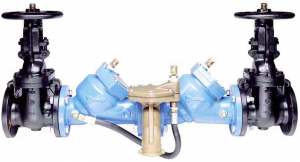Drinking Water Safety (Part 3)
THIS ARTICLE WAS ORIGINALLY PRINTED IN LOUISIANA CIVIL ENGINEER MAGAZINE, MAY 2011, VOLUME 19, NO. 3.
Protection of the potable water supply is the main goal of the regulations and the burden of maintaining that protection is placed on the water purveyor. One of the primary means of protecting the system is through education. An explanation to customers, along with examples, about what cross connections are can educate the general public of the dangers of cross connections and can aide in preventing contamination of the public water system. The installation of backflow preventers is another very useful tool in helping protect the water system.
Various makes and models of backflow preventers exist for the purpose of protecting the water supply and each serves its own purpose; however, only three “types” of testable (acceptable) backflow preventers are recognized as providing the required protection based on the degree of hazard. The three types of approved backflow preventers are the reduced pressure (zone) commonly referred to as an RP or RPZ (Figure 2), the double check (DC) (Figure 3), and the pressure vacuum breaker (PVB) (Figure 4). The RP and DC backflow preventers are also available in detector type assemblies. The detector assembly is used when continuous water supply is required to a facility (hospital, dialysis center, etc) and the water can not be turned off for testing purposes. The detector assembly consists of the host backflow preventer with a smaller (5/8” or ¾”) assembly and low flow meter installed in parallel to the host. Detector assemblies must be purchased as a complete unit and can not be fabricated by the plumber.



Many water systems currently install dual check valves on all customer water meters to aide in the protection of the water system. While this approach is well intentioned, dual checks (a device with two spring loaded check valves) are not considered adequate protection primarily because the dual check is not recognized as an approved backflow preventer. In order for an assembly to be approved, it must have two shut off valves, test cocks, and internally loaded spring check valves. The dual check has no shut off valves or test cocks and is not testable.
State regulations specify that the installation of backflow preventers can only be accomplished by Water Supply Protection Specialist (WSPS) endorsed plumbers. In order to obtain the endorsement, a master or journeyman plumber must successfully complete an approved 40-hour course of instruction. Managers of backflow prevention programs would be wise to ensure that those plumbers working within their system possess the endorsement to insure that the work is being performed properly. Experience reveals that improperly managed programs that have non-endorsed plumbers performing backflow work within their system contain installations that do not meet industry standards and state regulations. In some cases, non-endorsed plumber installations are so poor that they may actually be contributing to the contamination of the water system!
DHH is actively enforcing the regulations regarding cross connection control and backflow prevention. Several water systems currently have Administrative Orders requiring that backflow prevention programs be implemented in order to protect the safety of the drinking water. A thorough, complete, and comprehensive backflow prevention program will provide increased protection of a water system from accidental contamination. Regulations are available in the Louisiana Administrative Code and the Plumbing Code; however, the scope of work involved in getting a program implemented extends beyond the regulations. Additionally, several issues must be overcome to successfully implement a backflow program, namely – an incomplete understanding of the scope of a program, potential political consequences, education, and financial constraints. While many of these issues are not entirely foreign to the engineering community, the backflow industry presents new territory for many engineers in the community. It is our responsibility as engineers to do our part in helping to protect the public water supply and, in turn, the public health of the citizens of Louisiana.
